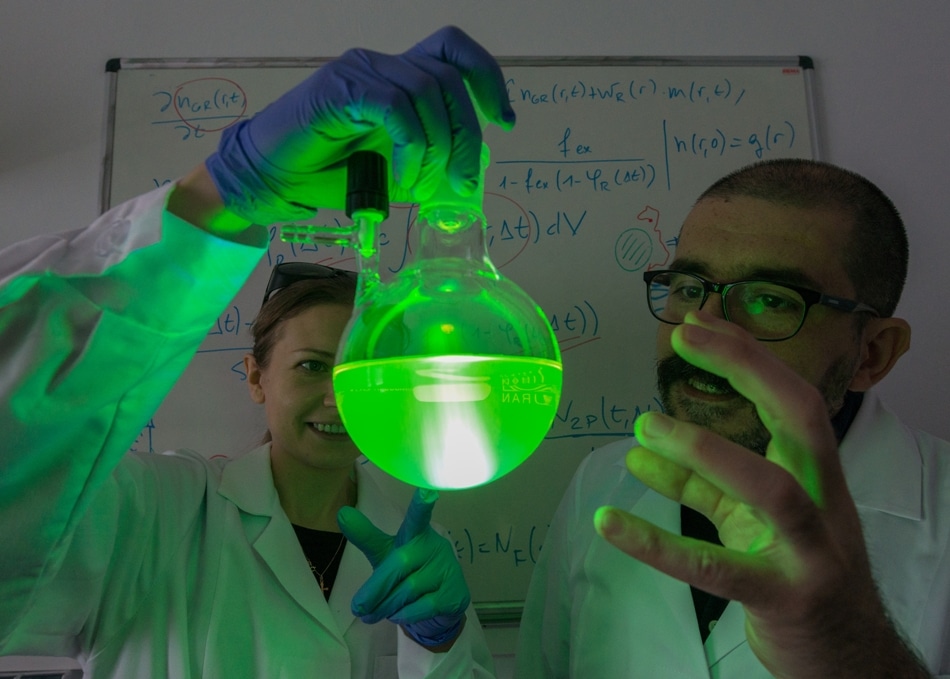May 5 2017
 Some chemical reactions can be accelerated by increasing the intensity of illumination – this has been demonstrated by researchers from the Institute of Physical Chemistry of the Polish Academy of Sciences in Warsaw. (Source: IPC PAS, Grzegorz Krzyzewski)
Some chemical reactions can be accelerated by increasing the intensity of illumination – this has been demonstrated by researchers from the Institute of Physical Chemistry of the Polish Academy of Sciences in Warsaw. (Source: IPC PAS, Grzegorz Krzyzewski)
Light initiates a number of chemical reactions. Experiments conducted at the Laser Centre of the Institute of Physical Chemistry of the Polish Academy of Sciences (IPC PAS) in Warsaw and the University of Warsaw's Faculty of Physics have demonstrated for the first time that increasing the intensity of illumination a few reactions can be considerably faster. In this case, acceleration was realized using pairs of ultra-short laser pulses.
So as to methodically examine the nature of the processes involved, the ultra-short consecutive pairs of laser pulses were used, and an increase in the rate of reaction between the molecules was witnessed by up to several dozen percent. The observations of the Warsaw researchers have been reported in the renowned scientific journal Physical Chemistry Chemical Physics.
Our experiments provide fundamental knowledge about the physical processes that are important for the course of important light-induced reactions. This knowledge can potentially be used in many applications, especially when dealing with high intensity light sources. These include, among others, various microscopic imaging techniques, ultra-fast spectroscopy as well as photovoltaics, particularly if light-focusing devices such as solar collectors are used.
Dr. Gonzalo Angulo, IPC PAS
In light-induced reactions, a photon with the suitable energy stimulates a molecule of dye. When there is a molecule of quencher close to the excited molecule, an interaction occurs: there could be a transfer of energy, a proton or an electron, between the two reactants. Reactions of this type are typical in nature. A good instance is electron transfer in photosynthesis, which plays a main role in the development of the Earth's ecosystem.
It turns out that a factor that can affect the quickening of reactions is the light’s intensity that initiates them. So as to examine the nature of the processes happening, the Warsaw researchers used laser pulses lasting femtoseconds rather than the traditional nonstop stream of light. The energy of the impulses was modified so that, under their impact, the dye molecules shifted into the excited energy state. The pulses were assembled in pairs. The interval between pulses in a pair was numerous dozen picoseconds (trillionths of a second) and was matched to the environment of the solution and the type of reacting molecules.
The theory and the experiments required care and attention, but the physical idea itself is quite simple here. In order for the reaction to occur, there must be a molecule of quencher near the light-excited dye molecule. So, if we have a pair of molecules that have already reacted with each other this means that they were close enough to each other. By increasing the number of photons in time, we thus increase the chance that if, after the reaction, both molecules have managed to return to their ground state, the absorption of a new photon by the dye has the potential to initiate another reaction before the molecules move away from each other in space.
Jadwiga Milkiewicz, PhD Student, IPC PAS
The course of reactions in solutions relied on a number of factors such as pressure, temperature, viscosity or the presence of an electric or magnetic field. The research at the IPC PAS has showed that these factors also impact the acceleration of the chemical reaction that happens with an increased intensity of lighting. Under certain conditions, the quickening of the reaction was imperceptible, in optimal conditions the rate of the reaction grew by up to 25-30%.
In our experiments so far, we have concentrated on light-induced electron transfer reactions, that is, those which change the electrical charge of the molecules. However, we do not see any reason why the mechanism we have observed could not function in other variations of these reactions. So, in the near future, we will try to confirm its efficacy in energy transfer reactions or in reactions involving also proton transfer.
Dr. Gonzalo Angulo, IPC PAS
Besides chemists and physicists from the IPC PAS and the Physics Faculty of the University of Warsaw, financed by the HARMONIA grant of the National Science Centre, a group headed by Prof. Gunther Grampp from Graz University of Technology participated in the experiments. In the Austrian laboratory, comparative experiments were performed on samples illuminated in a nonstop manner. Dr. Daniel Kattnig from the University of Oxford was also involved in the team's theoretical work. This press release was prepared with funds from the European ERA Chairs grant under the Horizon 2020 programme.